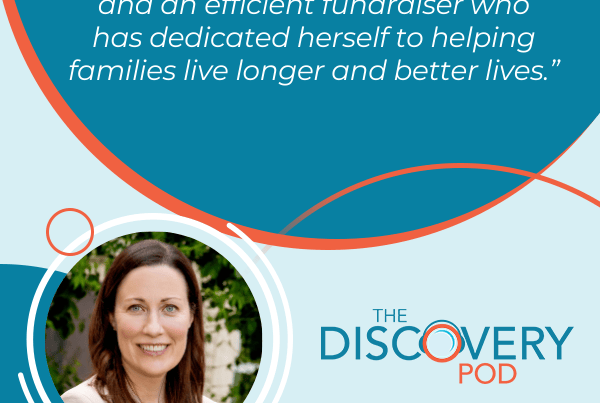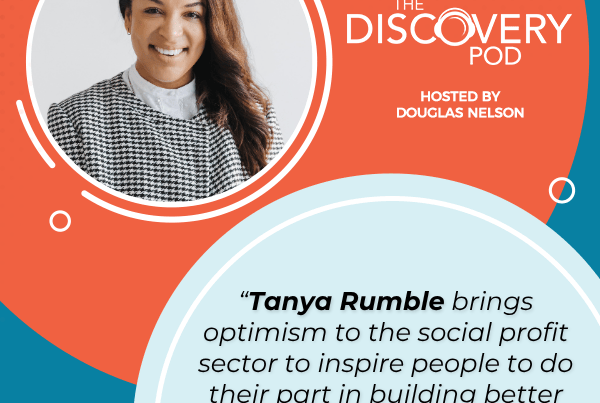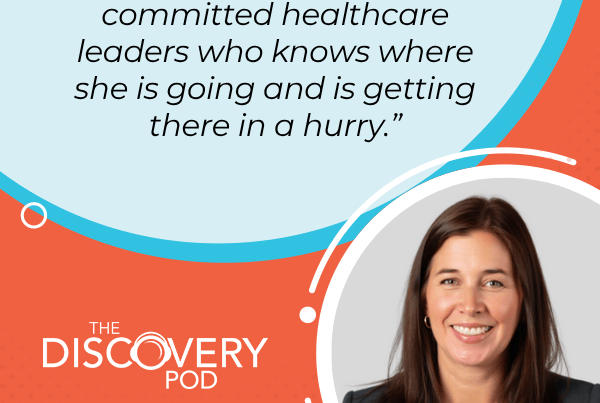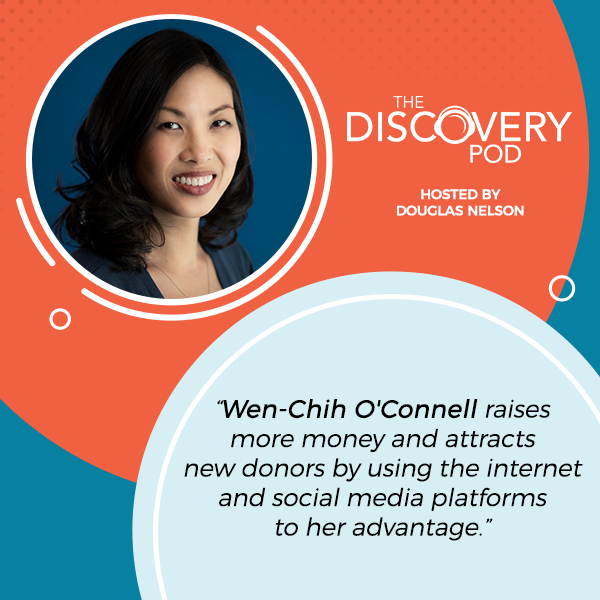
Almost everyone spends a huge chunk of their days glued to their phones and scrolling through endless online content. This engagement-rich virtual world must be leveraged by non-profit organizations when gathering charitable donations. Douglas Nelson sits down with Wen-Chih O’Connell, executive director of PayPal Giving Fund Canada, who supports charities raising funds through PayPal and other technological platforms. She explains why bringing your fundraising projects online is highly attractive to the younger generation, who desire transparency and speed above anything else. Wen-Chih also discusses how to overcome barriers to fundraising digitization and make online giving smoother and safer than ever before.
—
Listen to the podcast here
PayPal Giving Fund Canada With Wen-Chih O’Connell, Executive Director
Many of the organizations we have the privilege of working with here at the Discovery Group have been asked at some point, “What are you doing to engage that next generation of donors? How are we moving forward with building relationships with the youngest Canadians to bring them onside as donors to our organization so that we’re their first choice when it comes to philanthropic decision-making later on in their lives?”
It is one of the reasons why I’m so pleased to have our guest, Wen-Chih O’Connell. Wen-Chih is the executive director and president of PayPal Giving Fund Canada, where she and her colleagues work to increase funds raised online for Canadian charities by partnering with tech companies to integrate giving opportunities into their platforms.
We’re talking all of them, PayPal, Instagram, Facebook, GoFundMe, Twitch, and many others, and Wen-Chih knows the space. She has over twenty years of experience in the charitable giving sector, which ranges from implementing grassroots community projects as a Peace Corps volunteer to developing and refining fundraising, partnership, and community investment strategies for nonprofits, multinational corporations, and large grant-making foundations.
Our conversation is a deep dive into the world of digital giving and what it can mean for your organization. We spend a lot of time talking about what the barriers are to organizations accepting the help from PayPal Giving Canada and others that are attempting to support this digital transformation across our social profit sector. It’s a great conversation you won’t want to miss.
—
Wen-Chih, welcome to the show. It’s a pleasure to have you on The Discovery Pod.
I’m so pleased to be here. Thank you for having me, Doug.
Wen-Chih O’Connell Of PayPal Giving Fund Canada
I’m excited to share news of your organization and the work you’re doing in our sector because I think it’s an important answer that a number of our CEOs are hearing from their boards. What are we doing to attract younger donors? What are we doing online? You have the tools. You have the expertise to lead them on. Tell us a little bit about PayPal Giving Fund Canada, what you do, who you serve, and how you’re operating in our Canadian social profit sector.
PayPal Giving Fund Canada is a CRA-registered charity. Our goal is to make giving part of everyday life. We do that by working with tech companies to integrate charitable giving onto their online platforms that millions of people use every day. Charities can use the tools that we power on our partners’ online platforms to either fundraise for themselves or activate their supporters to leverage their networks to fundraise for the charity.
We partner with PayPal, Meta, which is Facebook and Instagram, GoFundMe, Twitch, Deed, and a few other partners. We’re always adding more partners as well. PayPal is one of our major partners. PayPal supports us through the programs that we power with them to enable giving on PayPal’s platforms, but also through operations, technology, and those things as well.
One of the things that drew you and your organization to my attention was your Future of Giving Reports. Can you tell us a little bit what those are and how organizations can use them?
We started out with our very first Future of Giving Reports a few years ago, where we wanted to dive into the data around how various generations give, what motivates them to give, and what challenges they are facing. Are they still going online? Are older generations going online? We saw a lot of movement to online giving with the pandemic, but we wanted to see if that is lasting. Is that going to continue? That was the first Future of Giving Report that we did, where we saw that there wasn’t very much data out there on the topic.
We wanted to provide that value to the sector, and so we did that. There were a lot of differences between generations. The feedback that we got from that report, and having done that report, we wanted to dive deeper into the younger generations. We wanted to understand more about Millennials and Gen Z, because they are the future of giving. They are going to be the ones that make up the bulk of the donor population in a few years.
They are the ones who are coming into their high-earning years, as well as receiving the transfer of wealth from older generations. We wanted to dive deeper there and see the things that younger generations are interested in doing. How are they giving? What are their thoughts around that? What are the platforms that they’re using, etc.?
What’s the answer? This is a question in our work here at the Discovery Group with clients across the country. Boards and leadership teams are saying, “What are we doing for our younger donors? How are we attracting that next generation of donors?” What’s motivating those donors? Where are they showing up? How are they giving?
I will plug our report and say, please read the report for all of the findings. We can chat a little bit about that. They are primarily online, as the younger generations are also more mobile on their mobile phones. They are on the platforms that they’re using every day. We asked them, “What are the platforms that you are using for your acts of generosity?” Not just social, but where you want to contribute to the community, where you want to be giving, and those kinds of things. The top platform that was for Millennials was Facebook, while the top platform for Gen Z was Instagram. There were late Millennials that an in-between group. It was mixed between the two.
You could see that Facebook was the top for older people. Instagram was the top for the younger generation. That was an interesting finding. GoFundMe was also in the top three across the board. That was another platform that they’re using. The key thing that we found in our first report was that younger generations want to know the impact of the donations that they’re making. They want to know the impact of these dollars that I would be giving to this charity or this cause.
Younger generations want to know the impact of the donations they are making. Share on XFor charities, communicating that impact is going to be important for them going forward. Those were some of the key findings there. The other thing that I found interesting was that Gen Z is interested in engaging with charities through leadership positions, through board service, more so than Millennials are. That was an interesting finding to me of how charities can engage those younger supporters in ways that can then inform the strategy and the operations of the organization. That could be a way, either through board service, committee service as well, having youth councils, and things like that, to be able to provide that voice of the younger generation.
Having A Clear Story And Impact
That’s a great insight. One of the things we’ve seen is clients that have made the distinction between their annual giving return through the mail and monthly donors. It’s a big age gap. Monthly donors tend to be significantly younger, especially those who sign up online. It skews another six years younger on average. What comes from those monthly donors is their motivation is more about purpose and outcome impact that you found in your report.
They view the organization not as an end in itself. We’re not giving to this environmental charity, this hospital, or this health charity. We’re giving to the outcome that those organizations seek to have in the world. It can be hard for some of the organizations to realize that they’re not viewed as the champion. They’re viewed as the means to achieve the outcome. I think there’s some ego involved, but it’s thinking about your organization as a means to an end, rather than the end itself. It can be hard for some organizations, particularly our older, more established organizations. What have you seen that works to help organizations get out of their own way in that front?
I would say that charities that think about the impact that they’re having on the cause that they’re working on can start with storytelling. You’re telling the story of the impact that you’re you’re having. A lot of charities are using social media to tell that story already. I think that’s where there is a lot of alignment with what younger donors or younger supporters are expecting. They’re expecting to see what is the impact of the support that you’re receiving as an organization.
I think that they’re thinking about how the organization is using those resources and that support in the most effective way to achieve that impact. For charities, having that clear story of what it is that they’re doing toward impact is going to then lead to their ability to gain more support from a financial standpoint as well.
Using Twitch For Fundraising
Can you think of an example of organizations that are doing this particularly well?
I had a conversation recently with the Edmonton Valley Zoo. We were talking about how they were using Twitch as a platform for their fundraising and for engaging with their supporters. They had told us this story about how they had a baby red panda at their zoo. Their supporters are super keen to see the baby panda. They want to see how the baby is doing, and they want to engage in that way.
The zoo wants to protect the baby and the time that the mother has. It wasn’t a time that they could have the babies out for the public to see. What the zoo decided to do was to use footage that they use to monitor the family. They use the Twitch platform, which is a video streaming platform, to be able to share information about the baby with their supporters.
Because we at PayPal Giving Fund power the giving, and we have that integrated giving opportunity on the Twitch platform, they were able to add a donate button on those streams and then generate a lot of funds that way. Their supporters are giving because they are keen to support the baby panda program that they have at the zoo. They were happy about being able to see the babies sooner than they would have had they not been able to have that insight online to be able to do that.
I love that it’s giving aligned with purpose in such a perfect way. That example shows the power of what you and your colleagues offer. I was surprised to see the order of magnitude of the dollars that you’ve helped your partner charities generate. I could say the number, but I think it’d be better if you did.
We are so pleased to have reached a milestone at the end of 2024, where we’ve generated over $200 million for charities across Canada since we launched PayPal Giving Fund. We’re pleased that we were able to generate, like you said, that volume of money, that volume of support for charities across the country. We’re looking forward to generating more going forward.
Taking The First Step Towards Digitization
You have these tools, and you can support giving on these platforms. The early adopter organizations that are like, “Yes, help us. Let’s get on with it,” I have certainly seen some great results in that. That total number of $200 million is a pretty powerful example that it can work, and it does work. What are some of the barriers you’ve seen for organizations that aren’t able to say yes or that? How do they get out of their own way to join the revolution and digitize giving in a more comprehensive way?
Honestly, I think that taking the first step is an important key. Realizing that you can do some very simple, easy things to start on your digitization journey. The tools that PayPal Giving Fund is powering and that we offer are easy, low risk, no cost ways for charities to start receiving funds digitally, to start leveraging some of these platforms in a way that is up to the organization to decide how best to integrate those things and what is best for their organization, what makes sense for the resources that they have and the things that they want to be doing.
We have some small charities that are using PayPal Giving Fund tools. They point all of their supporters to their page on the PayPal fundraising site to give through that. One hundred percent of the funds that are donated through that page and the PayPal mobile app get to the charities. At PayPal Giving Fund, we don’t charge anything for the work that we do because we’re supported by our partners, and PayPal is covering the fees on that platform that they have.
That’s one way that small charities can start to receive online donations without any kind of integration. They don’t have any kind of initial outlay or resource output to that. They literally can just point people to these pages. Same with Facebook. If you have a Facebook page and you don’t have a website, you can onboard with Facebook. All of these tools are free. You can start adding donate buttons to your Facebook page. You can start Facebook fundraisers, and you can encourage your supporters to do the same. Same thing on Instagram. Same thing on GoFundMe.
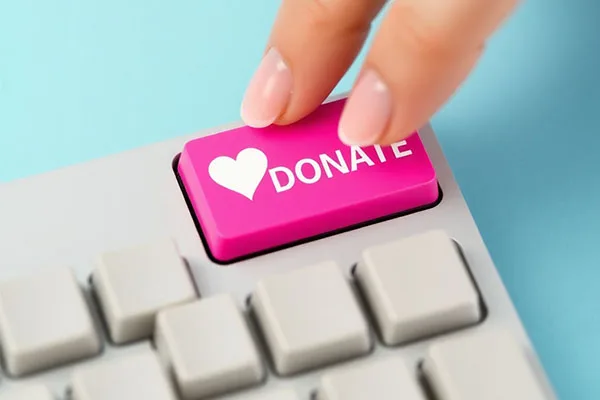
Charitable Donations: You can start adding ‘Donate’ buttons to your Facebook page or start a fundraiser.
On GoFundMe, you can start fundraising using those tools, all of the things that they’ve built, the resources that they have that they’re offering to not just charities, but everyone, the public, but charities in particular in this context, to be able to fundraise, to tell the story, and to add photos, videos, updates, and things like that. There are small ways that charities can start using some of these tools.
Some of the bigger charities that have their own digital fundraising strategies, driving all of their fundraising to their own platforms and things like that, still view these tools as additional and supplementary to what they’re doing. They’re not going to ignore these platforms because these are the platforms that some of their supporters are using. They’re accessing audiences that are there that might not be willing or wanting to go to their own platforms. This can be an addition to anything that they’re doing. It doesn’t have to replace what they’re doing as an organization and driving their own fundraising internally.
How To Get Started With Digitization
It sounds like you’ve given a lot of thought and done a lot of work to lower the barriers for people to be a partner with you at PayPal Giving Fund. I want to go back to something we touched on a little earlier in the conversation. You mentioned the pandemic as a great example of the importance of digitizing your fundraising and what that can look like. In Canada, we had another opportunity to test that with the postal strike leading into the holiday season at the end of 2024. For those organizations that didn’t get the memo the first time, there was a second iteration of it.
I had a conversation with the CEO, who has a very effective online giving program. She was saying that they did everything that they could for their mail program to drive to online giving, but it didn’t work. The people who want to give through the mail want to give through the mail, and there’s not much that can convince them. That said, the effort to convince their mail donors to give online brought in a significant number of new donors to the organization because they were trying to show up on many of the platforms that you mentioned. For organizations that are ready to read the memo but without needing a third crisis to push them more into that digitization, how can they get started?
Our first step is encouraging charities to enroll with us. Enrolling with us is simply having or signing up for a PayPal business account, essentially going through the validation process to say that you’re a charity, and then you’re enrolled. Going through that process of enrollment enables charities to be able to access a whole lot more information, not just donation data, donor data, where it’s shared, as well as information in a dashboard that they have access to. It also enables them to be able to update their profile, add their logo, and add their mission statement. All of those pieces of their profile port through to our various partners.
Our various partners will pull different parts of that profile into their platforms, so that it shows up on their platforms. For the charity, it’s easier because there’s only one profile that they have to update ongoing, and it ports across all the platforms. It’s a better experience for their donors because their donors see the logo and their mission statement. They know this is the right organization that they want to support.
It’s better for us as well. It’s easier for us to be able to get funds to them. We’re able to pay them more quickly electronically as opposed to by check. It’s funny because that same challenge that charities are having, convincing their donors to give electronically or digitally and not by check, is the same one that we experience in terms of convincing charities to then enroll with us and receive funds electronically as opposed to via a check in the mail. That would be the first step.
Can I ask this? You would have organizations that have their donors give electronically through your platform and then want a mailed check rather than a digital transfer?
Yes.
Not all barriers are predictable. I wouldn’t have seen that one coming.
I know that there is a journey, and there are organizations at various parts of that journey. I don’t want to dissuade anyone from starting to use these tools and starting to engage with donors online and digitally, even if they, as an organization, are still stuck on receiving checks. At the same time, like I said, with enrollment, you do get access to more information. You are able to then get that donor information where it’s been shared and be able to reach out and thank the donor who gave those donations and things like that. It’s a first step. There’s no initial outlay. There’s no payment expectation or anything like that. You enroll. The PayPal account is free. You receive the funds, and you can use the funds towards your charitable purpose.

Charitable Donations: With enrollment, you get access to more donor information.
PayPal Giving Fund issues the donation receipts to all of the donors. That is an administrative burden that’s taken off the charity for all the funds that they receive from us. Donors are on these platforms. We’ve done all the work to integrate that giving opportunity on those platforms. I hope that charities will take full advantage of that because it’s there. The tools are there.
How To Convince Leaders To Try Online Fundraisers
That sounds like a lot of them are. You’ve certainly seen some impressive growth in the organizations that are taking you up on that offer. Many in our audience are heads of fundraising, CEOs, or executive directors in their organizations. They may have someone in their organization or likely have someone who is in charge of community giving, online giving, or the annual fund that may be bringing the case to them, saying, “We should look at this PayPal Giving Fund.” What advice would you have for that program leader who needs to convince their executive team that this is something they should try or something they should add to the program that they’re responsible for?
It’s the platforms and the audience on those platforms. For a lot of these charities, they’re already posting on the platforms. They know they have to post. They have social media. They’re posting about things. It’s adding the giving opportunity. It’s adding the donate button or adding a request for the supporters to start a fundraiser, to support them for their birthday, or what have you. It’s that little extra thing of saying, “Let’s take advantage of the giving aspect or the giving tool that’s in this platform,” and add that to the social media posts that they’ve already made about the impact that they’re having. It’s a very simple thing that charities can do to leverage that.
In terms of making the case, I think the case has already been made for some of these charities, where they’re already posting on these platforms. It’s a matter of how we add that fundraising component to it, and what’s the best way to do that. For the organizations where they’re not online, the case can be made just from the data from our report, where younger people are online. That’s where they’re expecting to give. That’s where they’re expecting to engage with charities and with the causes that they care about, and to learn about the causes that they care about. They’re doing that online. To even show up to that swath of people, you need to be online, and this is an easy way to do it.
Many young people expect they can donate to charities through the internet. Share on XI think every leader in large, midsize, and small organizations has either been asked or asked themselves, “What are we doing to attract that next generation of donors? What are we doing to attract young people to our organization?” The aging of the Baby Boomers is causing a lot of organizations to say, “What’s that next generation?” In health care, the average age of a major gift donor is over 60. Their young donors are in their 50s. For a lot of other social purpose and social movement type organizations, donors who are going to be much younger are probably much more willing to adapt to services like the one that you’ve shared about.
From my perspective, to explore what can happen through the PayPal Giving Fund is an answer for CEOs, for heads of fundraising to say, “This is what we’re doing to try and build to explore how our messaging tests how our younger generations respond to our message and our organization in a way that isn’t about diverting hundreds of thousands of dollars to invest in something online if you are on online platform, which I’ve seen some organizations do. This is a way to start learning about how your organization shows up for those younger donors on those platforms that you support, and learn and iterate as to how they can make that a little better.
Raising Funds Through Facebook And Instagram
I think there’s an important, valuable service that you’re offering to the sector, which is why I wanted to have you on to talk about it. There’s the practicality of raising more money and attracting new donors. Yes, very valuable. Many of the people that I spend my days hanging out with are being asked, “What are we doing about all of this anyway?” You’ve got a valuable tool for them and a way for their organizations to explore this. Are there examples of larger organizations that have come on board and seen the light?
Yes. I’ll mention the Canadian Cancer Society. They have done a whole lot of fundraising on the various platforms that we power. We had talked to them about the Facebook challenges that they started in 2023. They started doing a few Facebook challenges solely on Facebook. I think they’ve been doing them quarterly since. That’s been pretty successful for them. When they initially tried it out, they were surprised at how successful it was for them at the time. That was why they decided to keep going and do more.
Another example is Plan International Canada. We saw that they had put together tutorials on Instagram to help their supporters leverage the Instagram fundraising tools, and did a campaign to encourage Instagram fundraising. That was a great way for them to engage with their supporters and then activate their supporters into fundraising for them, and to engage and talk about the impact that their organization has with their own networks. We’re always working to bring on more partners as well. We have partners in the pipeline that we’ll be adding. It’s all part of the PayPal Giving Fund family of partners. For charities that enroll with PayPal Giving Fund will already be able to benefit from those new partners as they come online as well.
Tech Innovation In The Charitable Sector
Through your work, you’ve had a full immersion into the Canadian social profit sector and all of the exciting stories, some of which you’ve shared some of the challenges that I’m sure you’ve encountered along your journey. What has surprised you most about the charitable sector in our country?
What surprised me most was how far along that digitization path many charities are. I was surprised at how many charities were still attached to the check system, checks in the mail, paper checks, and things like that. That was a bit of a surprise for me, and a bit of learning for me as well, especially being in this role where we want to get funds to charities, and to have that as something where it wasn’t just, “Do you know that you can receive funds electronically?” We have heard a number of charities say, “Yes, we know, but we still prefer to receive checks.” It’s fine. They can, but that was a surprise to me coming into this.
I think that the more that we, as a collective sector, with your help, with other organizations that are beating that drum of we need to go digital, all of that is going to help. We’re happy to partner and be part of that drumbeat of this needs to happen for the future of the sector and for the future of all these organizations that are doing good work. It’s a matter of making sure that they can get support for that good work going forward into the future.

Charitable Donations: Organizations need to go digital. This needs to happen for the future of the social profit sector and the future of all these organizations.
I couldn’t agree more with you. The audience has heard me say this a few times, but I’m going to say it again. I think one of the biggest risks to our sector is that the world outside the social profit sector is changing so much more quickly than the work inside our social profit sector. When we look up or look out, we may find ourselves further behind than we can catch up. I’ve certainly seen that happen to some organizations. Being aware of and at least having exposure to the pace, change, and opportunity of technology is an essential part of any viable, sustainable, thriving, and exceptional social profit organization. Opting out is not an option.
I feel like we’re doing our small part in trying to connect that inside the sector versus outside the sector. We’re trying to incorporate that giving and that social mindset into these for-profit platforms. They’re driving and developing technology in these platforms that millions of people are using. How do we connect in, and how do we access those audiences? Being able to integrate that is one way that we’re able to essentially open and unlock that door for charities to access those audiences.
Millions of people use social media platforms. Charities must learn how to unlock that door and access those audiences. Share on XHow And When To Digitize
It’s where the donors are. Go fundraising where the donors are. Go fishing where the fish are. It’s age-old. As we come to the end of our conversation, what are you looking forward to?
I’m looking forward to a day when it’s not a conversation of whether to digitize. It’s more of a conversation about how, when, and how we improve the digitization. I’m looking forward to seeing how these younger generations shape our sector. That’s a big one. Not just as donors, but also within the sector as people who are coming up in the ranks and who are starting their own organizations and doing that work. I’m looking forward to that.
I think the future looks bright in the sense that when I engage with younger people or when I engage with people on my staff who are younger, they have great ideas. All of this whole digitization is so normal and so part of life for them that it’s going to be amazing to see what comes of it with AI. AI is the internet from my age, where it’s like, “What is this internet thing?” We were one of the first generations to grow up with the internet as being quite normal.
The questions then were, how is it going to affect education? You don’t have to learn. You don’t have to look up things in the encyclopedia. You don’t have to memorize things because you look them up at a moment’s notice. How is that going to impact? We’d been able to leverage all of that and build and create new and amazing things. I think the same thing is going to happen with AI. That’s going to be exciting to see how things progress and how these young people transform our society and our sector.
Watch this space for AI giving tools coming soon.
We’ll see.
Episode Wrap-up And Closing Words
Wen-Chih, thank you so much for making time to be on The Discovery Pod. I think you’re doing great work and offering a valuable service to our sector. Thank you for that work, and thank you for your insights.
Thank you so much for taking the time to chat with me and for sharing about us with your audience as well. Thanks so much, Doug.

